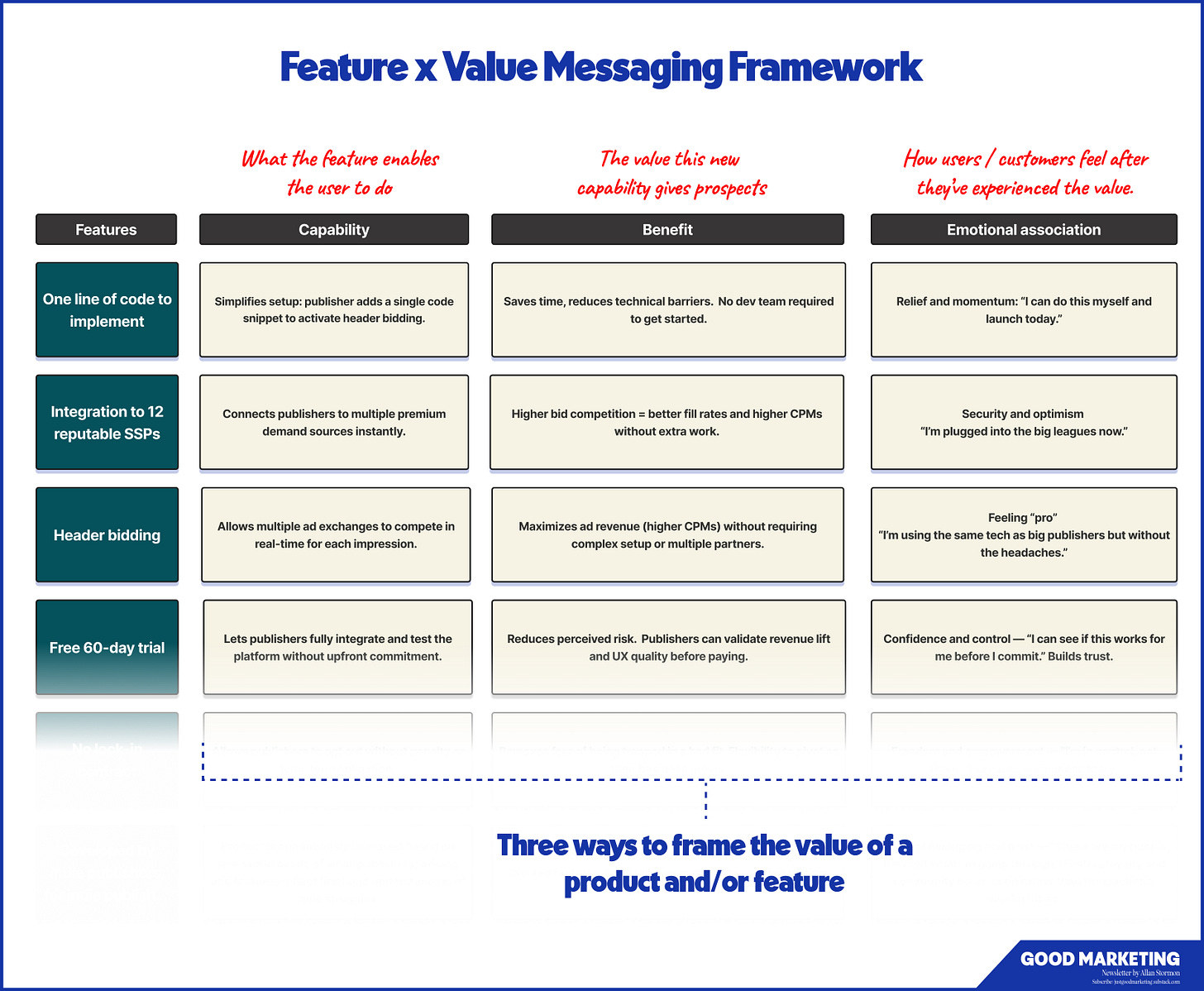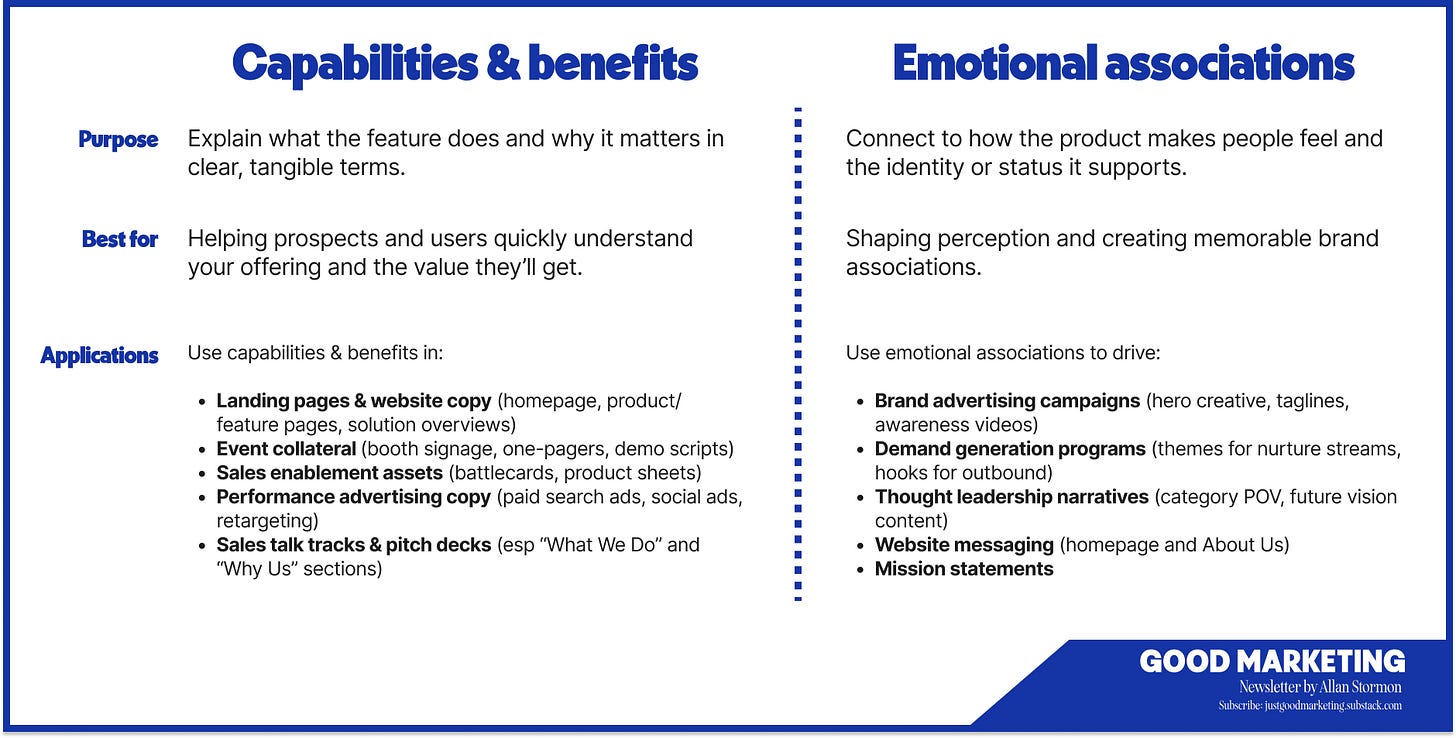The Last Messaging Framework You’ll Ever Need
Free template & example included
“Increase revenue”
“Save time”
“Work smarter”
The only thing more unoriginal than using these promises in marketing copy is writing a blog post about a messaging framework.
And yet, here we are… the irony.
Yes, we’re talking about messaging frameworks, specifically the one I’ve stitched together, picked at, and pruned over the years in various roles both in-house and consulting.
Why bother with a messaging framework?
Because messaging is a fundamental part of marketing, it goes hand in hand with positioning—a core element of the strategic process.
Great messaging communicates value clearly and simply, in a way that’s specific, emotive, and free of tired, overused value propositions. The framework I’m sharing today is designed to do exactly that.
Let’s get to it.
The Feature x Value Messaging Framework
Access the Google Sheets example & template here
In the images below, I’ve shared an example of the framework I completed recently for a client in the AdTech industry. You can also access a Google Sheets version with the same example copy and template you can duplicate for your own use.
This simple messaging framework solves two problems.
It helps you break down every feature into three levels of value, providing a range of messaging options to use depending on the project you’re working on.
It helps you structure and add hierarchy to features based on the target segment you’re focused on. So, when you’re planning an event, writing a landing page, or developing a campaign theme for a specific audience, you know what features you should focus on and how to frame the value.
The three levels of value
Let’s get one thing straight: 99% of B2B products are intended to save money and/or make money for customers.
Which is why you see some variation of the same value proposition everywhere: “drive more revenue”, “cut costs”, “save time”, etc.
But we don’t want to do that because that messaging is:
a) too high level for most prospects to care about (CEO excluded)
b) overused and forgettable
c) lazy and a cop-out
So we need to get specific. Hence, the three levels of value form the main part of the framework.
Each feature’s value is broken down into three layers:
Capability: What the feature enables the user to do. This is tangible and factual.
Benefit: What does the capability do for the end user? The emphasis is on practical outcomes.
Emotional association: What is the feeling associated with the benefit? The focus is on the emotional state of the end user.
These three layers are levers you can pull in different contexts, and they work in different ways.
Capabilities and benefits are great for informing landing page copy, website copy, ad creative for performance campaigns or sales enablement materials.
Other times, emotional associations work better, especially as inspiration for campaign themes, thought leadership programs, and sales narratives.
Below is a summary and some suggestions for the practical use of each value level.
The point is: you now have variety. Multiple ways to talk about your product without falling back on the same tired lines every time.
Feature prioritization and messaging hierarchy
The other element to this framework is providing an easy way to determine what features and messaging is relevant to certain segments and audiences.
That’s why the framework includes a priority feature section where you can list the top features for each target segment. If you’re serving multiple segments, each with its own needs and preferences, you need a quick, visual way to see which features matter most to each group.
This is about structure as much as it is about relevance. By mapping priorities, you can arrange copy on a page, slide, or ad so that the most important points are presented first, and the rest flows logically.
Done well, it tells a clear, compelling story for every audience you serve.
Who should use this framework?
Every marketer should be strong at messaging and be able to articulate the value of products and features properly. In this sense, the framework is for all types of marketers. But if you’re looking for specific roles:
Product marketers who want a better way to simplify, structure, and organize their messaging so it’s easier to share and communicate across teams and functions.
Content marketers who want to quickly understand the relevant features and benefits for specific audiences to inform landing pages copy, campaign assets, and web page copy.
Demand generation marketers who need to develop campaign themes and outreach messaging for SDRs.
Performance marketers who need a quick reference guide for themes to drive ad copy and creative.
Final thought
A final note on how to write effective messaging.
Keep it simple and concise.
Effective messaging and the frameworks used to document it should be easy for fellow team members to both understand and remember. That way, they’ll be better equipped to recite it and articulate the product’s value to prospects, customers, and fellow coworkers.
If your messaging framework is a spreadsheet with 100s of cells and thousands of words of copy, no one will bother reading it, let alone apply it to memory. And then, not only will your marketing suffer, but all the hard work will be for nothing.
Use short sentences, and for the love of clarity, use simple words, too.
That’s it for this week.
Be good out there.
Allan
P.S. Framework template available here
P.P.S. If you have a marketer in mind who you think would find this helpful, I’d love it if you could share it with them.







